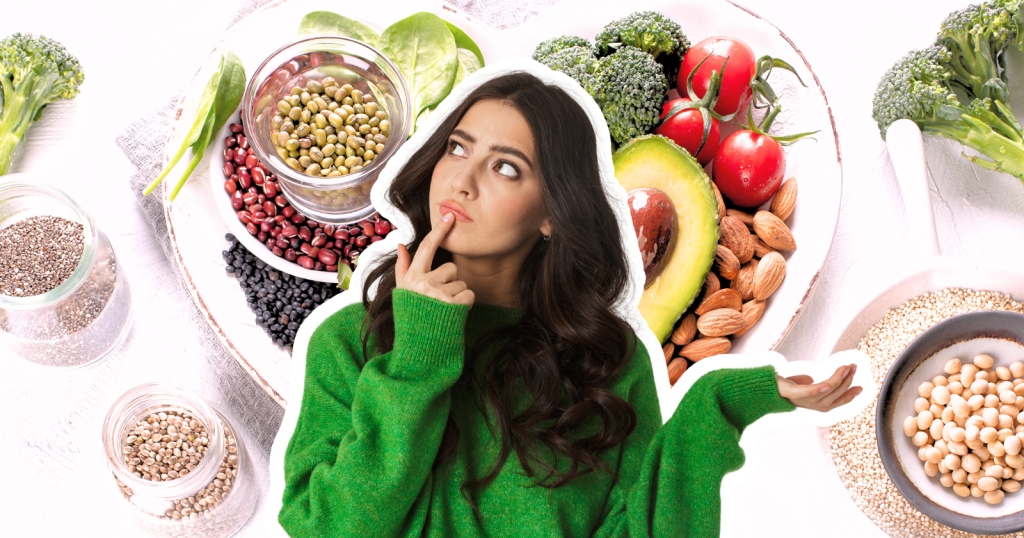Crafting a kinder plate should not require myth-busting, yet here we are.
Let’s clear the fog fast and keep it practical.
Below are seven stubborn myths I hear all the time, and what I have learned from research and lived experience:
1) Protein is hard to get
This one hangs on like a bad chorus.
If you eat enough calories from a variety of plant foods, you will hit your protein needs with ease.
Beans, lentils, tofu, tempeh, seitan, edamame, peas, whole grains, nuts, and seeds all bring solid protein to the party.
Even vegetables like broccoli and spinach chip in.
The trick is simple patterns; a bowl of lentil chili with quinoa, a tofu stir fry with rice and cashews, or a chickpea wrap with tahini and greens.
What about “complete” proteins? Your body is smart as it pulls amino acids from your daily intake and combines them.
You do not need to juggle rice and beans in the same bite.
Eat variety over the day, and you are covered.
2) You will be tired all day
Energy dips do not come from plants because they come from poor planning.
Vegetarian meals that balance complex carbs, protein, and fat keep blood sugar steady; oats with peanut butter and berries, soba with edamame and sesame, and Greek yogurt with walnuts and fruit if you eat dairy.
These do not lead to a crash.
If fatigue shows up, it is usually about total calories, hydration, sleep, or a missing micronutrient.
Iron, vitamin B12, and iodine are worth attention.
Fortified foods and smart supplementation can close the loop.
Most people feel lighter, not slower, when they shift to fiber-rich meals that digest clean.
3) It is too expensive
Some of the most budget friendly staples on Earth are vegetarian.
Dried beans, lentils, rice, oats, potatoes, frozen veggies, cabbage, carrots, peanut butter; these are value kings.
Costs rise when every meal leans on specialty faux meats or imported snacks.
Those are nice to have, not must haves.
Batch cooking a pot of dal, roasting a tray of vegetables, or prepping overnight oats cuts spending and decision fatigue.
I learned this the hard way during a photo assignment that had me traveling across California on a shoestring.
I lived on burrito bowls I built from grocery store ingredients.
Beans, rice, salsa, avocado, lettuce; cheap, filling, and repeatable.
My wallet did not complain!
4) You cannot build muscle
Tell that to the lifters crushing pull-ups on tofu and tempeh.
Muscle responds to two main levers, progressive resistance and adequate protein.
Vegetarians can do both!
Target about 1.6 to 2.2 grams of protein per kilogram of body weight if you are pushing hard in the gym.
Hit that with tofu, tempeh, seitan, dairy if you use it, eggs if you include them, legumes, and protein-rich grains like farro.
A simple protein shake can help if appetite lags.
Training quality still rules; sleep, volume, progressive overload, and consistency matter more than where the protein comes from.
The barbell does not care if your reps run on lentils.
5) You will miss out socially
Food is culture, but culture is flexible.
Most restaurants have solid plant forward options if you scan the menu with intent.
Pasta arrabbiata, veggie sushi, bean-based tacos, Indian thalis, Mediterranean mezze, grain bowls; even steak houses have baked potatoes and grilled veggies that can become a real meal with a salad and a side of beans.
Hosting or being hosted? Offer to bring a dish that can anchor the table.
I bring a big tray of roasted vegetables with chimichurri or a peanut noodle salad.
People eat it first, then ask for the recipe.
The fastest way to defuse tension is to lead with ease, not rules.
Say “I am good with anything plant based” and keep the focus on the company, not your plate.
6) It is all or nothing
Labels can be helpful, they can also trap us.
The goal is to align your choices with your values, health, and reality.
If going fully vegetarian today feels like a leap, start with one meatless meal a day or pick a theme night.
Taco Tuesday with beans, Stir fry Friday with tofu, or breakfast every day without meat.
Small shifts compound.
When I got serious, I built a short list of defaults I could make with my eyes closed.
A smoothie with oats and peanut butter, a tofu scramble with veggies and toast, and pasta with tomato sauce, olives, and a can of chickpeas.
Defaults remove friction.
Over time, the identity piece catches up with the habit piece.
7) It solves every problem
A plant heavy diet can lower risk for a bunch of issues, and it is kinder to animals and often the planet, but it is not a magic shield.
You still need enough calories, enough sleep, and movement that challenges your heart and muscles.
Chips and soda can be vegetarian, so can a life with no sunlight.
The psychology matters too: If food becomes a source of constant stress, the benefits shrink.
I like to treat my diet as a supportive tool, not a scoreboard.
I ask simple questions: Does this meal help me feel clear and strong later today? Does it support the kind of person I am trying to become?
Perfection thinking is a trap, while progress thinking is a compass.
A few closing thoughts
Most myths survive because they contain a tiny slice of truth.
Yes, you should plan for nutrients like iron and B12, and change can feel awkward at first, but none of that adds up to a deal breaker.
Start with pattern over perfection.
Build a small rotation of meals you enjoy and can repeat.
Keep staples on hand, and pay attention to how you feel and adjust.
I am a vegan writer who spends a lot of time with research and a lot of time in actual kitchens.
The science and the lived reality point to the same place.
A thoughtful vegetarian pattern is doable, affordable, energizing, and aligned with a better future.
If a myth tries to grab the mic, turn the volume down and let your experience lead.
What’s Your Plant-Powered Archetype?
Ever wonder what your everyday habits say about your deeper purpose—and how they ripple out to impact the planet?
This 90-second quiz reveals the plant-powered role you’re here to play, and the tiny shift that makes it even more powerful.
12 fun questions. Instant results. Surprisingly accurate.
First Appeared on
Source link











